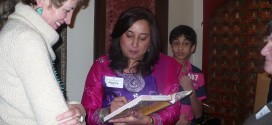By Vanessa Wang
Monica Bhide always wanted to be a fiction writer, but instead she became an engineer and later wrote three successful Indian cookbooks. She quickly became one of Mashable’s top ten food writers on Twitter. This October, she finally publishes her first short story collection, The Devil In Us, a book that brings us back and forth between India and America through stories of love, life, and redemption. The book is among the top 40 bestsellers on Amazon under the short story category. Monica talks to us about her journey in becoming a writer from India to America.

Monica spent her first six years of life in India, grew up in the Middle East, went back to India for college, and arrived in the U.S. when she was 21. Monica’s love for writing was apparent since high school, when she wrote “a lot of dark and intense poetry and stories.” Her parents did not support her dream, deeming writing an impractical way of earning a living, so instead of pursuing her passion, Monica came to the states in 1991 and earned two master degrees in engineering. She worked in corporate America for thirteen years. “I liked my job,” says Monica, “but it was never something that spoke to me; it was just a job.”
A turning point in Monica’s life came around ten years ago, when one of her closest friends passed away. “It made me examine my life closely,” she tells us. “I kept going back to the fact that I wanted to write. They say write about what you love, so I wrote about food.” Monica became very successful in her food writing; her essays were published in New York Times, Washington Post, NPR, etc. But she was also writing fiction on her own. After working on her stories for ten years, Monica began contacting literary publishers last year. The publishers were impressed with Monica’s writing but wanted her to write a novel instead because novels were easier to sell. Monica finally decided to self-publish The Devil In Us.
 The Devil In Us is written in the style of vignettes. When asked for the inspiration behind the story collection, Monica tells us that she “likes the idea of being an outsider looking into people’s lives.” “As I wrote I imagined pulling aside the curtains and staring into someone’s living room. I consider myself a very nosy person, and what I kept asking myself was: what would I see?” Monica says the people around her have inspired her writing, but the stories are, for the most part, made up. As a book that brings us back and forth between India and America, The Devil In Us is written in English with occasional Indian words in dialogue, “to make the stories authentic.” There is a list of Indian words and all their translations at the very end of the book. When it was first released, the book climbed to the top 100 Amazon Short Stories list.
The Devil In Us is written in the style of vignettes. When asked for the inspiration behind the story collection, Monica tells us that she “likes the idea of being an outsider looking into people’s lives.” “As I wrote I imagined pulling aside the curtains and staring into someone’s living room. I consider myself a very nosy person, and what I kept asking myself was: what would I see?” Monica says the people around her have inspired her writing, but the stories are, for the most part, made up. As a book that brings us back and forth between India and America, The Devil In Us is written in English with occasional Indian words in dialogue, “to make the stories authentic.” There is a list of Indian words and all their translations at the very end of the book. When it was first released, the book climbed to the top 100 Amazon Short Stories list.
Monica says she considers it a huge blessing to be an Asian American writer. “In some ways, I feel like a stranger to both cultures,” says Monica. “I feel very lucky to look at the American culture as someone who’s not from here, and to look at India as someone who left a long time ago. But I also feel that I belong to both places, and when you are part of two cultures, there is so much fodder for creativity. You can pick and choose and pretty much play with anything you want from each culture.” Monica’s two favorite Indian writers are Chitra Banerjee Divakaruni and Rohinton Mistry.
When asked about the challenges Asian American writers face, Monica tells us a story of her friend, who is an Indian cookbook writer but loves Italian food. “She’s really good at Italian food, but she says nobody will accept her as an Italian food writer because she’s Indian. Still, I think every challenge can be turned into an opportunity. I have friends who use pen names when they write about cultures other than their own.”
Monica’s second collection of short stories is scheduled to come out in March 2015. The book is magic realism and set in a city called Nirvana. The stories are all connected: a character from one story becomes the protagonist in the following story and you need to get to the very end to understand what happens at the beginning. The book questions our perceptions of what we think is real: unusual, crazy facts in the book are real while the mundane stuff is all made up. “I’ll leave you with that for now,” says Monica. Monica also has a collection of food essays called “A Life of Spice” coming out in December. Learn more about Monica Bhide and her books on http://monicabhide.com.
 Asian Fortune Your source for all things Asian American
Asian Fortune Your source for all things Asian American

